Global Perspectives
Musical Form: Two Case Studies from Asia
As we have seen, musical forms in the Classical style become quite elaborate. It is certainly no accident that these intricate designs emerged across the eighteenth century, just when independent instrumental music was gaining unprecedented prestige in the European tradition. Instrumental music often seems to require such complexities. It is as if the removal of other determinants of form — a poem set to music, a specific religious ritual, or a pattern of dance steps — calls for a different, more abstract musical organization.
Taking the broadest view of these complex forms, however, we can see that they work changes through a simple process. Composers state a tune and then repeat it throughout a movement, joining with it contrasting elements either complex (sonata form, first-
Other traditions of instrumental music around the world also start from this concept and elaborate it, building intricate forms. In this segment we offer a historical snapshot of two Asian instrumental traditions, from Japan and Indonesia, and we examine music from each.
Japan
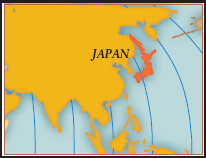
The symphony orchestra as we know it emerged in the seventeenth century as a reflection of the power and splendor of European courts (see page 99). In Japan, a court orchestra had been established a thousand years earlier. This was the period in Japanese history, from the sixth century C.E. to the eighth, when the first centralized control of the islands emerged. The new Japanese central government, many of its institutions, and even its newly constructed capital city of Nara were modeled on the greatest empire in Asia, China. In the process, many elements of Chinese culture were imported to Japan — most importantly Buddhism, which had in turn come to China from India centuries before.
The new Japanese court also imported various musical styles from continental Asia. These were altered and developed into an independent Japanese tradition, which came to play an important role in the court’s ceremony and ritual. Altogether, these styles are known as gagaku (gáh-
The gagaku repertory is divided into two parts. One, known as togaku (tóh-
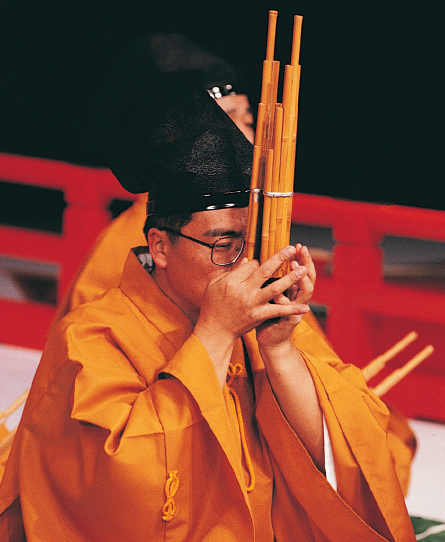
The Japanese Togaku Orchestra The togaku orchestra is so distinctive, and so different from any European orchestra, that we should spend a moment getting to know the various instruments. While European orchestras are dominated by strings, all gagaku orchestras feature wind instruments. The instruments all have specific functions:
- The sliding, wailing double-
reed hichiriki (hée- chee- ree- kée) carries the main melody. Several are heard on our recording, playing together. - The side-
blown flute called ryuteki (ree- óo- tay- kée) is the first instrument heard. It plays the melody along with the hichirikis, though in a slightly different version. This is called a heterophonic texture; heterophony is an important feature in many non- Western musics. - The sho, a mouth reed-
organ with seventeen pipes, plays chordal clusters of tones derived from the main melody. This unusual instrument contributes a haunting background of harmonic haze to the texture. - The kakko, a two-
headed barrel drum played with sticks, is used for single strokes or short rolls. It is the first drum heard. - A deep, larger barrel drum, tsuridaiko (tzóo-
ree- díe- koh; its first beat is heard at 0:13), marks off long phrases of the melody with two successive strokes, the first soft and the second louder. - A biwa, or four-
stringed lute (bée- wah, first plucked at 1:11), strums across several strings quickly, punc- tuating the melody. - A gakuso, a zither with thirteen strings (gáh-
kóo- so, first heard at 1:31), plays short motives, mainly of three notes related, again, to the melody. Both the biwa and the gakuso take a more active role as this performance proceeds, finally even playing some of the main melody.
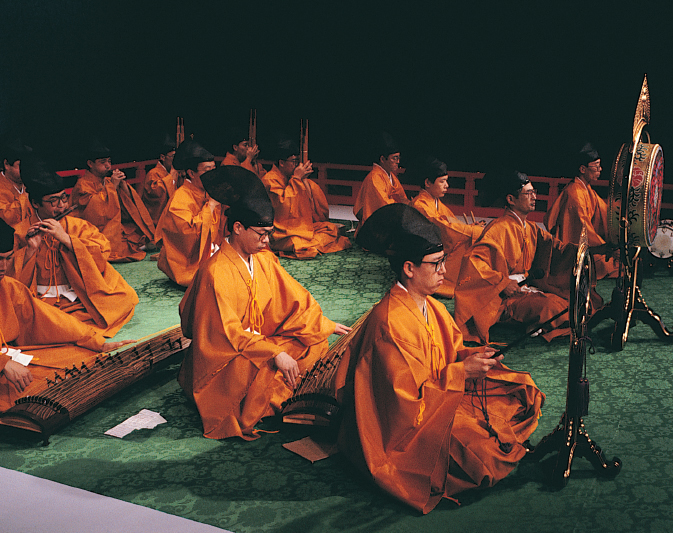

Etenraku Etenraku is the most famous piece for the togaku orchestra. Its name means “music of divinity,” and it emanates a deep, powerful calm associated with Buddhist contemplation. This is probably the oldest music on our recordings; in some form it reaches back almost to the origins of gagaku itself.
The musical form of this piece exhibits three characteristics of gagaku music. First, the piece as a whole is constructed from a single melody, according to a predetermined plan and without improvisation. In Etenraku the melody consists of three phrases, labeled a, b, and c in the musical example and Listen box on this page. Each phrase is 32 beats long. (The beats move by slowly at first, so slowly that the phrases can be hard to discern until you get used to the melody.)
Second, the instruments of the orchestra are introduced gradually and in a predetermined order as they fulfill their various functions. The melody is played through by some of the instruments and punctuated by others, as described above.
Third, the beat quickens, the meter is more clearly marked, and the general musical activity increases as the performance proceeds. At first, while the flute alone carries the melody, the beats are very slow and flexible — the music seems almost to have no meter at all. (Each pair of beats on the tsuridaiko, however, coming 16 very slow beats after the last, provides a certain sense of regularity and meter.) When the double-
Meanwhile the tempo gradually quickens: At the outset the beats come every 2–
Even at this relatively quick tempo, the music never loses its sense of restraint. Virtuosic playing is strictly avoided. Etenraku’s aura of quiet, inward-

LISTEN
Etenraku
| 0:00 | a | Ryuteki, kakko, tsuridaiko only |
| 0:51 | Sho and hichirikis enter. | |
| 1:11 | a | Biwa enters. |
| 1:31 | Gakuso enters, completing the orchestra. | |
| 2:18 | b | |
| 3:15 | b | |
| 4:04 | c | Paired beats of tsuridaiko every 8 beats |
| 4:46 | c | Gakuso and biwa gradually play more and more fragments of the main melody, joining in the heterophony of hichirikis and ryuteki. |
| 5:25 | a | |
| 6:02 | a | |
| 6:37 | b | |
| 7:11 | b | After the phrase is completed (at 7:55), biwa and gakuso end the piece with a brief coda. |
Indonesia
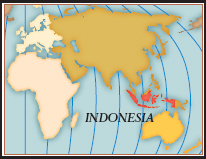
The Southeast Asian Republic of Indonesia consists of some six thousand islands in all, half of them inhabited. The central island is Java. Across Indonesia, ensembles playing traditional musics thrive — alongside, these days, many kinds of pop, rock, and world beat ensembles, especially in large urban centers such as Jakarta. A traditional musical ensemble in Indonesia is called a gamelan.
The Indonesian Orchestra: Gamelan Gamelans assume a wide, even bewildering variety of shapes and sizes, as we might expect of musical traditions that extend back many centuries and that have served an array of religious, political, and social functions. Gamelans may involve three or four musicians, or they may involve dozens. They sometimes include singers. They frequently accompany drama or dance: sacred temple dances, danced dramas, or the famous Indonesian shadow-
At the heart of gamelan music stands a great variety of gongs and metallophones (instruments like a xylophone, with metal keys). Indeed the word gong itself comes to us from Java, where it names (and also evokes the sound of ) the largest gamelan instrument.
Balinese Gamelans Nowhere in Indonesia are game-
Gamelans seem to have come to Bali in the sixteenth century, brought from Java by aristocratic refugees when their Hindu kingdom fell to Islamic invaders from the Asian mainland. Balinese gamelans, at least the elaborate ones with many instruments, were associated especially with temples and princely courts. When Bali came under colonial control of the Netherlands in 1906, the courts declined, but their traditions of gamelan music did not simply disappear. Instead they were taken over more and more by village gamelan clubs, and these are the main venue in which Balinese gamelan music continues today.
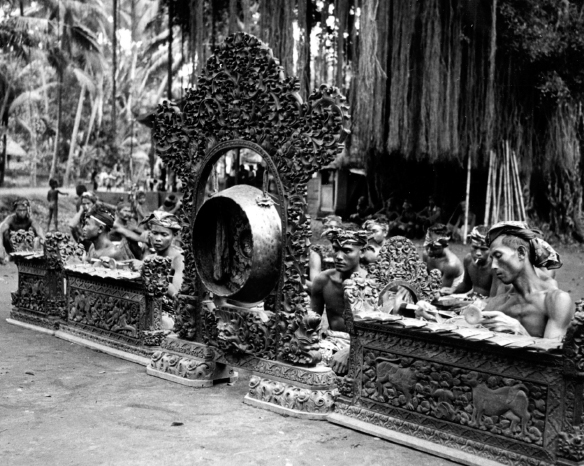
Gamelan Pelegongan Gamelan pelegongan, heard on our recording, is a type of Balinese orchestra used primarily to accompany elaborate dance-
- Two hand-
beaten drums. (The drummers direct the ensemble.) - Several gongs of varying sizes.
- A large group of metallophones, some low-
pitched, some high. Most of these have five metal keys each, with a range of a single octave, while some have thirteen keys and a wider range. The sounds, construction, and names of these metallophones vary, but all of them can be called by the umbrella term gangsa, “bronze.” - One or two bamboo flutes. What Western ears might hear as “out of tune-
ness” in their playing is a quality cultivated and prized by Balinese musicians.
Form in Gamelan Music A traditional piece for gamelan is usually organized around the repetition of a long, symmetrical melody. This melody is made up of smaller, equal phrases, generally 8 or 16 beats long, so that the whole melody will last a multiple of these numbers, especially 64 or 128 beats. A central group of instruments in the gamelan presents this melody. At the same time it may be played by other instruments in a simpler version, mainly in even note values, creating a heterophonic presentation.

At the end of each statement of the melody, the largest, deepest gong in the orchestra sounds. The unit between one gong stroke and the next, known as a gongan, is considered the basic structural unit for the piece. The gongan is divided into smaller units by other instruments in the gamelan: first into two units by a higher-
This process of division continues right through the rhythmic level of the main melody, so that certain instruments elaborate upon its pitches twice as fast, four times as fast, perhaps even eight times as fast.
The whole texture, then, is an elaborately stratified polyphony, with rhythmic layers ranging from the gongan itself all the way down to subdivisions of individual beats. Each instrument or each instrumental group plays a single role, occupying one of these rhythmic strata. In the midst of it all is the melody of the piece at hand, presented in one version or simultaneously in distinct versions.
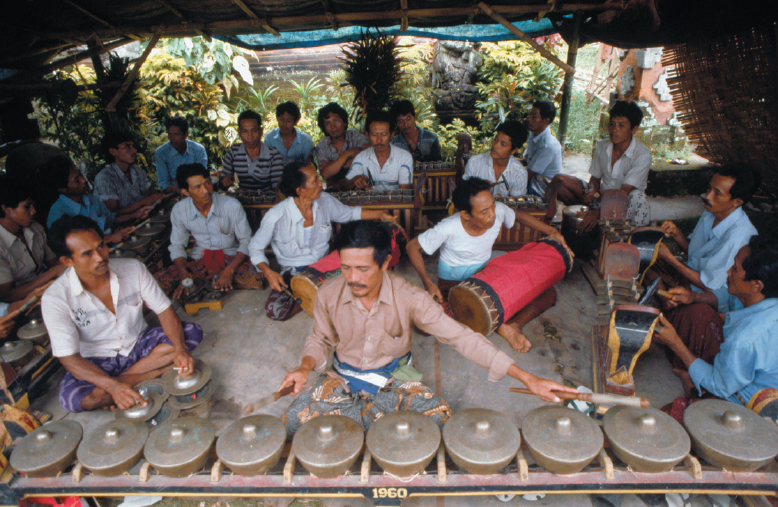
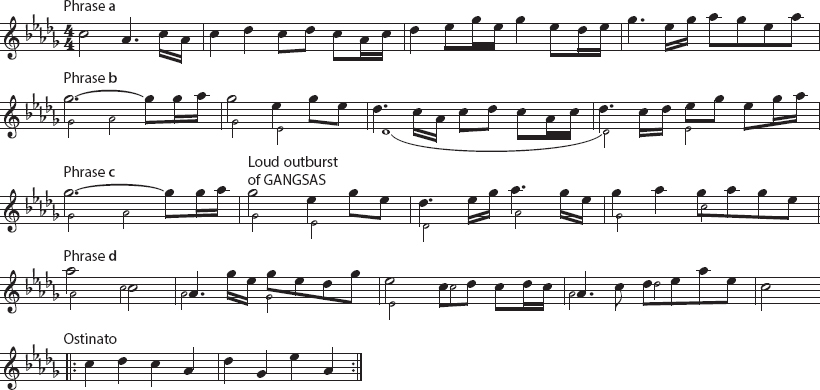
Bopong The piece on our recording, Bopong, is not a full dance piece but instead a sort of brief overture, played before the dancing begins. It was composed by I Lotring, a famous Balinese master musician born about 1900 and involved in many stylistic innovations of the 1920s and 1930s.
The main melody is played through three times; this is the heart of the piece. Before it we hear introductory material, partly based on the main melody. After it comes a lengthy, separate section with an ostinato (see page 119), and then a new concluding melody played by the whole gamelan.
The beats of the melody move slightly faster than one beat per second. The melody is 64 beats long and composed of four phrases of 16 beats each. The large gong sounds at the end of the 64-
The core melody, the most prominent melody you hear, is played by some of the gangsas and by two flutes, one high-
Around this melody is woven faster figuration, dividing each beat you count into four, played by brittle-
The third statement of the melody speeds up toward the end but does not quite finish. An entirely new melodic phrase breaks in to start a different section of the piece. Beginning at 2:41, some of the gangsas play a single, eight-
Finally, all this energy is channeled into a single closing melody with striking syncopations (see page 7), played in unison by most of the gamelan.
LISTEN
I Lotring, Bopong
| 0:00 | Introduction: a few gangsas alone |
| 0:04 | Gong; introduction continues with fast gangsa figuration. |
| 0:30 | Gong; first statement of melody begins. |
| 1:19 | Gong; second statement of melody |
| 2:06 | Gong; third statement of melody |
| 2:38 | Melody truncated |
| 2:41 | Ostinato begins (fourteen times through); gong every eight beats. |
| 4:04 | Syncopated, unison closing melody |
| 4:21 | Final gong stroke |